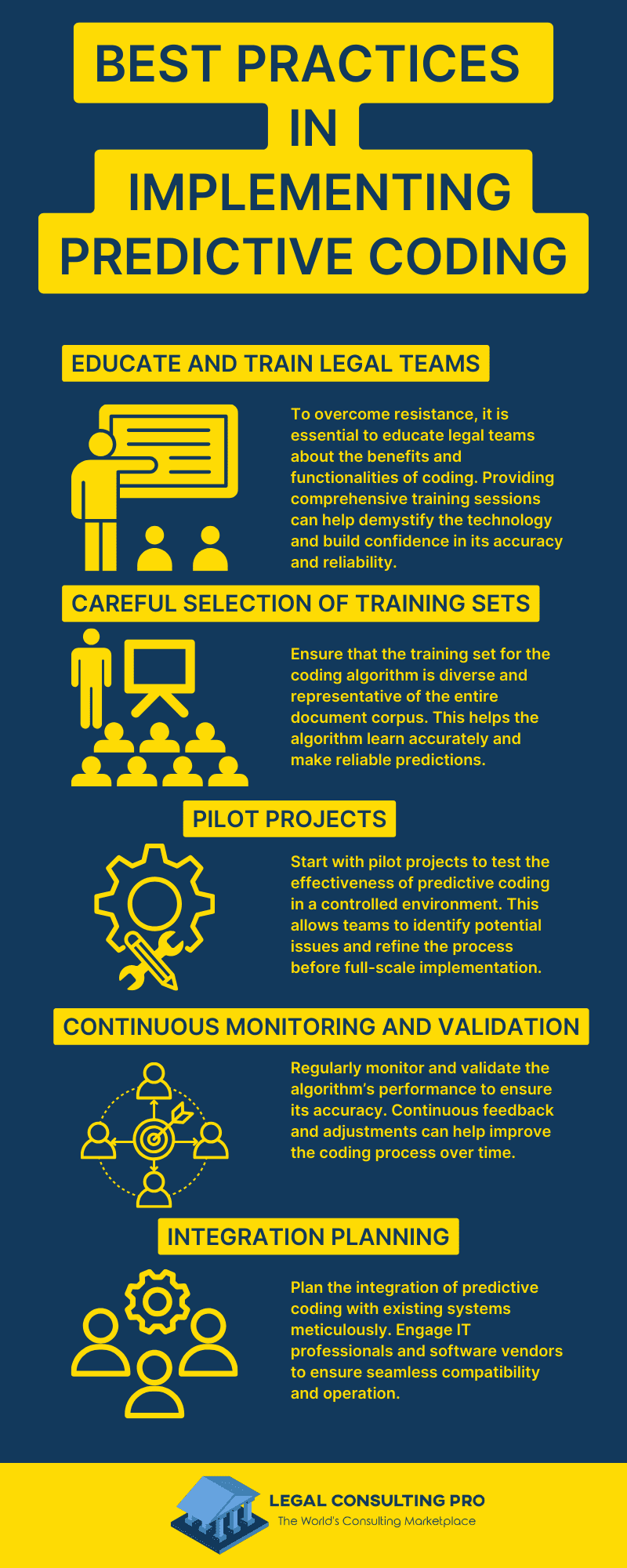Predictive coding and managed document review are transformative tools in the realm of legal technology, significantly enhancing the efficiency and accuracy of document review processes. Predictive coding, also known as technology-assisted review (TAR), employs machine learning algorithms to categorize and prioritize documents based on relevance, while document review involves the strategic oversight and coordination of document review projects. Despite their benefits, implementing these technologies presents several challenges. This article explores common obstacles and offers best practices for successfully leveraging coding and managed document review.
Challenges in Implementing Predictive Coding
-
Initial Resistance and Skepticism
One of the most significant challenges in implementing coding is the initial resistance and skepticism from legal professionals. Many attorneys are accustomed to traditional linear review methods and may doubt the reliability and accuracy of predictive coding. Convincing them to trust and adopt a technology-driven approach can be difficult.
-
Training the Algorithm
Coding relies heavily on the quality of the training set. Selecting representative documents to train the algorithm is crucial. If the training set is biased or unrepresentative, the algorithm’s predictions will be inaccurate, leading to potentially critical errors in document classification.
-
Integration with Existing Systems
Integrating predictive coding with existing document management and review systems can be complex. Ensuring compatibility and seamless operation without disrupting ongoing processes requires careful planning and execution.
-
Managing Large Volumes of Data
Coding must handle vast volumes of data, which can be overwhelming. The sheer quantity of documents can strain resources and affect the efficiency of the review process.
-
Ensuring Data Security and Confidentiality
Data security is paramount in legal practices. Implementing predictive coding involves uploading sensitive documents to software platforms, and raising concerns about data breaches and confidentiality breaches.
Challenges in Managed Document Review
Coordination and Communication
Effective document review requires robust coordination and communication among team members. Miscommunication can lead to inconsistencies in document classification and review decisions.
Quality Control
Maintaining high standards of accuracy and consistency in document review is challenging. Managed document review teams must ensure that reviewers adhere to established protocols and quality benchmarks.
Time Constraints
Legal cases often operate under tight deadlines. Ensuring that document review is completed efficiently without compromising quality is a significant challenge in document review.
Reviewer Expertise
The expertise of document reviewers varies, affecting the consistency and accuracy of review decisions. Ensuring that all reviewers are adequately trained and knowledgeable about the case is essential.
Cost Management
Managing costs is a critical concern in managed document review. Balancing the need for a thorough review with budget constraints requires strategic planning and resource allocation.
Best Practices in Implementing Predictive Coding
Educate and Train Legal Teams
To overcome resistance, it is essential to educate legal teams about the benefits and functionalities of coding. Providing comprehensive training sessions can help demystify the technology and build confidence in its accuracy and reliability.
Careful Selection of Training Sets
Ensure that the training set for the coding algorithm is diverse and representative of the entire document corpus. This helps the algorithm learn accurately and make reliable predictions.
Pilot Projects
Start with pilot projects to test the effectiveness of predictive coding in a controlled environment. This allows teams to identify potential issues and refine the process before full-scale implementation.
Continuous Monitoring and Validation
Regularly monitor and validate the algorithm’s performance to ensure its accuracy. Continuous feedback and adjustments can help improve the coding process over time.
Integration Planning
Plan the integration of predictive coding with existing systems meticulously. Engage IT professionals and software vendors to ensure seamless compatibility and operation.

Best Practices in Managed Document Review
- Clear Communication Channels: Establish clear communication channels among all team members. Use collaboration tools and regular meetings to ensure everyone is on the same page and aware of their responsibilities.
- Robust Quality Control Measures: Implement robust quality control measures to maintain consistency and accuracy in document review. Regularly audit the work of reviewers and provide feedback to ensure adherence to protocols.
- Efficient Project Management: Use project management tools to track progress and manage deadlines effectively. Assign tasks strategically to balance the workload and ensure timely completion of the review process.
- Training and Development: Invest in the training and development of document reviewers. Ensure they have a thorough understanding of the case and the review protocols to maintain high standards of accuracy and consistency.
- Cost-effective Strategies: Develop cost-effective strategies to manage resources efficiently. Use technology and automation where possible to reduce manual effort and manage costs effectively.
Case Studies
Case Study 1: Law Firm A’s Implementation of Predictive Coding
Law Firm A faced the challenge of reviewing millions of documents for a complex litigation case. Traditional linear review methods were proving to be time-consuming and costly. The firm decided to implement coding to streamline the process.
Challenge: The primary challenge was the initial resistance from senior attorneys who were skeptical about the accuracy of coding.
Solution: The firm conducted comprehensive training sessions and demonstrated the benefits of predictive coding through pilot projects. They carefully selected a representative training set and continuously monitored the algorithm’s performance.
Outcome: The implementation of coding reduced the review time by 50% and significantly lowered costs. The legal team was able to focus on high-priority documents, improving the overall efficiency of the review process.
Case Study 2: Company B’s Managed Document Review Strategy
Company B needed to review a large volume of documents for a regulatory compliance audit. They decided to use a document review approach to ensure accuracy and efficiency.
Challenge: The main challenge was coordinating the efforts of a large team of reviewers and maintaining high standards of quality control.
Solution: Company B established clear communication channels and used project management tools to track progress. They implemented robust quality control measures, including regular audits and feedback sessions. Additionally, they invested in the training and development of reviewers to ensure consistency in document classification.
Outcome: The document review strategy enabled Company B to complete the audit on time and within budget. The quality control measures ensured high accuracy, and the training programs improved the expertise of the review team.
Future Trends in Predictive Coding and Managed Document Review
- Artificial Intelligence and Machine Learning: Advancements in artificial intelligence and machine learning will further enhance the capabilities of coding and document review. These technologies will become more accurate and efficient, enabling faster and more reliable document classification.
- Integration with Other Legal Technologies: Predictive coding and document review will increasingly integrate with other legal technologies, such as e-discovery platforms and case management systems. This integration will streamline workflows and improve overall efficiency.
- Improved Data Security Measures: As concerns about data security and confidentiality grow, there will be a greater focus on implementing robust security measures. This will include encryption, access controls, and compliance with data protection regulations.
- Increased Adoption of Coding: As legal professionals become more familiar with the benefits of predictive coding, its adoption will continue to increase. More law firms and legal departments will leverage this technology to improve the efficiency and accuracy of their document review processes.
- Enhanced Training and Development Programs: The importance of training and development for document reviewers will be increasingly recognized. Organizations will invest in comprehensive training programs to ensure reviewers have the necessary skills and knowledge to perform their tasks effectively.
Conclusion
Implementing coding and managed document review offers significant benefits in terms of efficiency, accuracy, and cost savings. However, these technologies also present several challenges, including resistance from legal professionals, training the algorithm, and managing large volumes of data. By following best practices, such as educating legal teams, careful selection of training sets, and robust quality control measures, organizations can successfully overcome these challenges and leverage coding and document review to their full potential. The future of these technologies is promising, with advancements in AI and machine learning, integration with other legal technologies, and improved data security measures paving the way for even greater efficiency and accuracy in document review processes.
Similar blogs:
Predictive Coding: Ethical Considerations: Ensuring Fairness and Accuracy
5 Key Benefits of Predictive Coding for Efficient Document Review







































